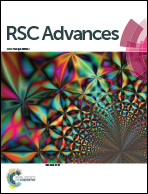Large-scale synthesis and catalytic activity of nanoporous Cu–O system towards CO oxidation
Abstract
Nanoporous Cu–O system catalysts with different oxidation states of Cu have been fabricated through a combination of dealloying as-milled Al66.7Cu33.3 alloy powders and subsequent thermal annealing. X-ray diffraction (XRD), field-emission scanning electron microscopy (FESEM), transmission electron microscopy (TEM) and X-ray photoelectron spectroscopy (XPS) have been used to characterize the microstructure and surface chemical states of Cu–O catalysts. The peculiar nanoporous structure can be retained in Cu–O catalysts after thermal treatment. Catalytic experiments reveal that all the Cu–O samples exhibit complete CO conversion below 170 °C. The optimal catalytic performance could be achieved through the combination of annealing in air with hydrogen treatment for the Cu–O catalyst, which shows a near complete conversion temperature (T90%) of 132 °C and an activation energy of 91.3 KJ mol−1. In addition, the present strategy (ball milling, dealloying and subsequent thermal treatment) could be scaled up to fabricate high-performance Cu–O catalysts towards CO oxidation.


 Please wait while we load your content...
Please wait while we load your content...